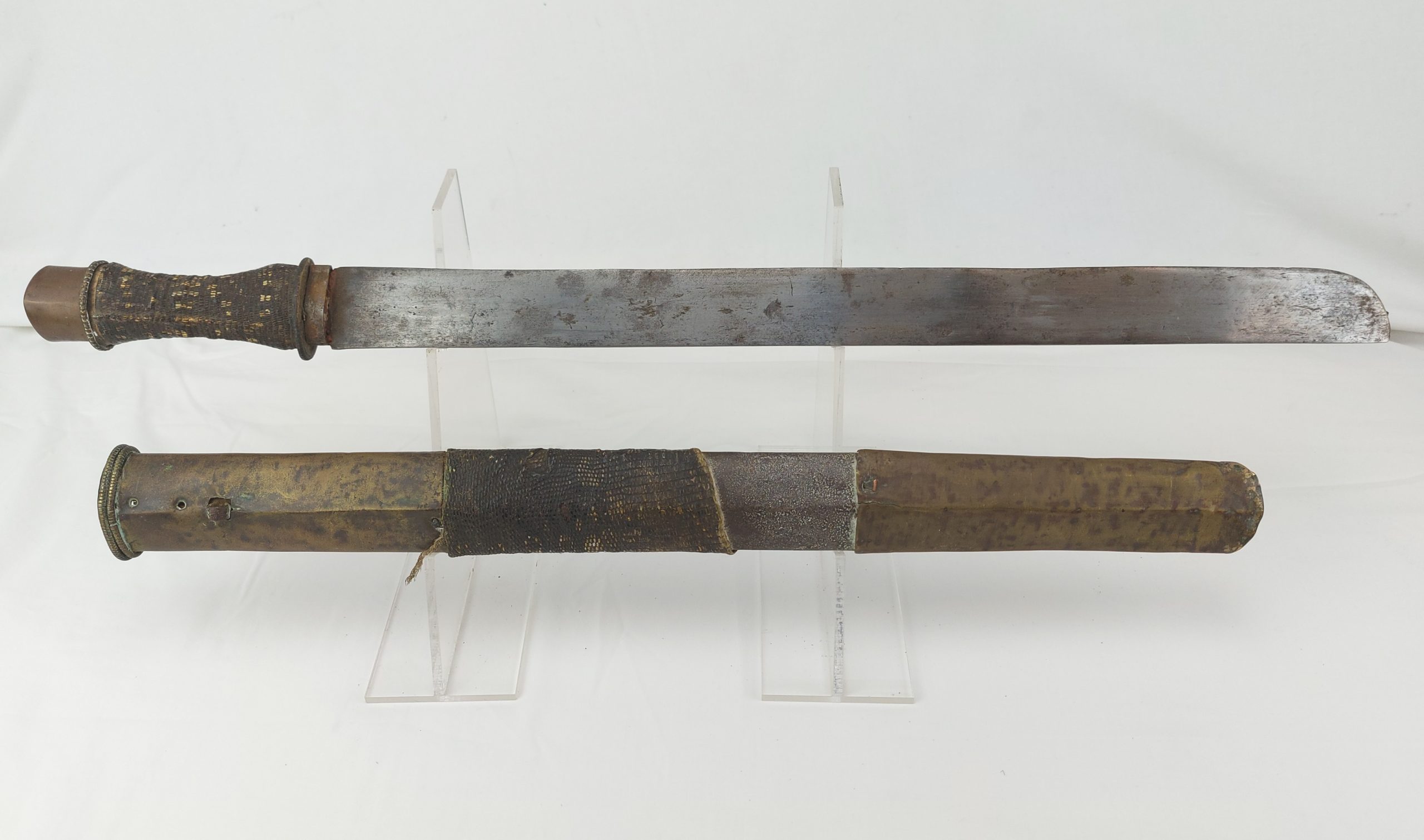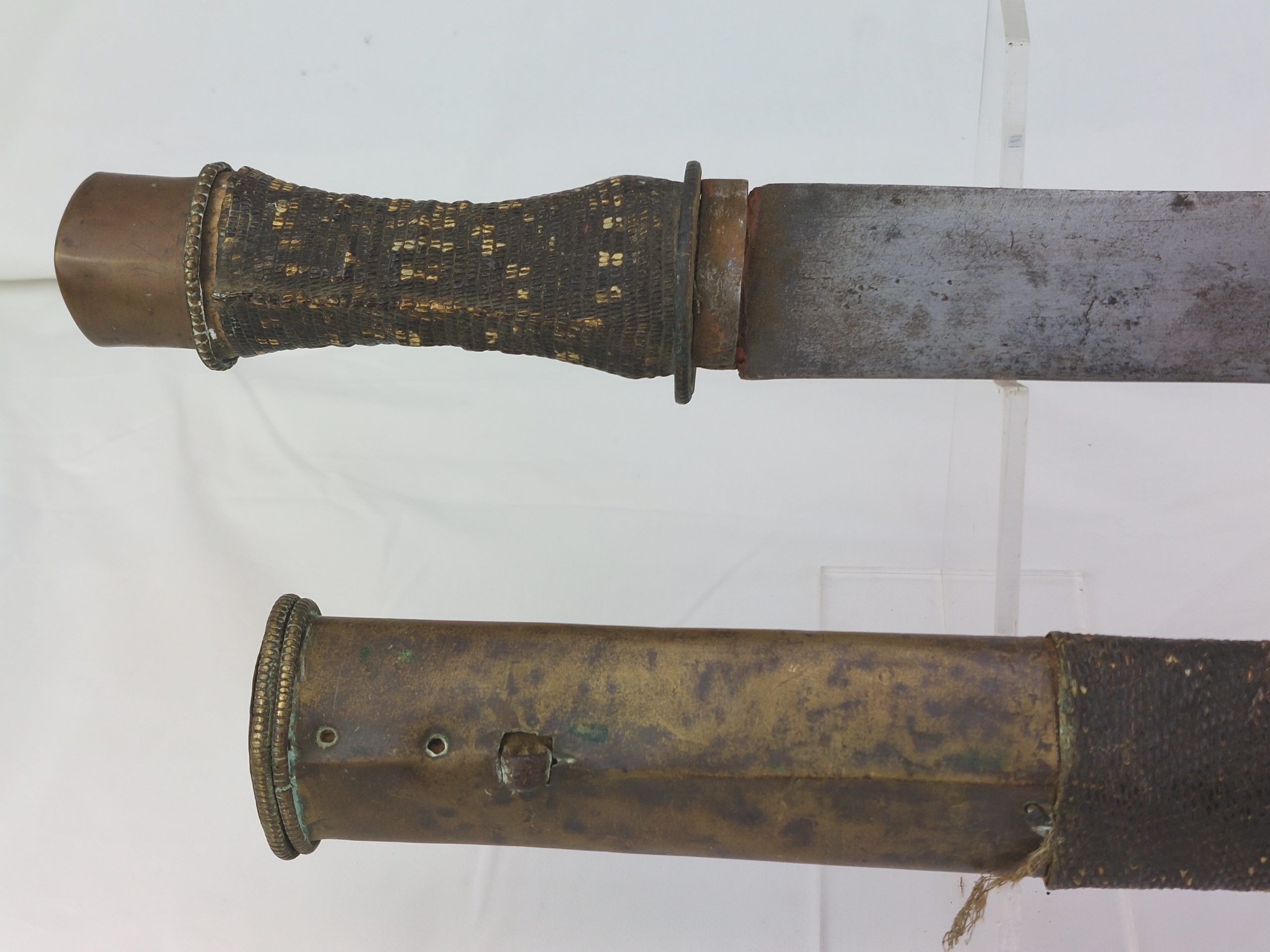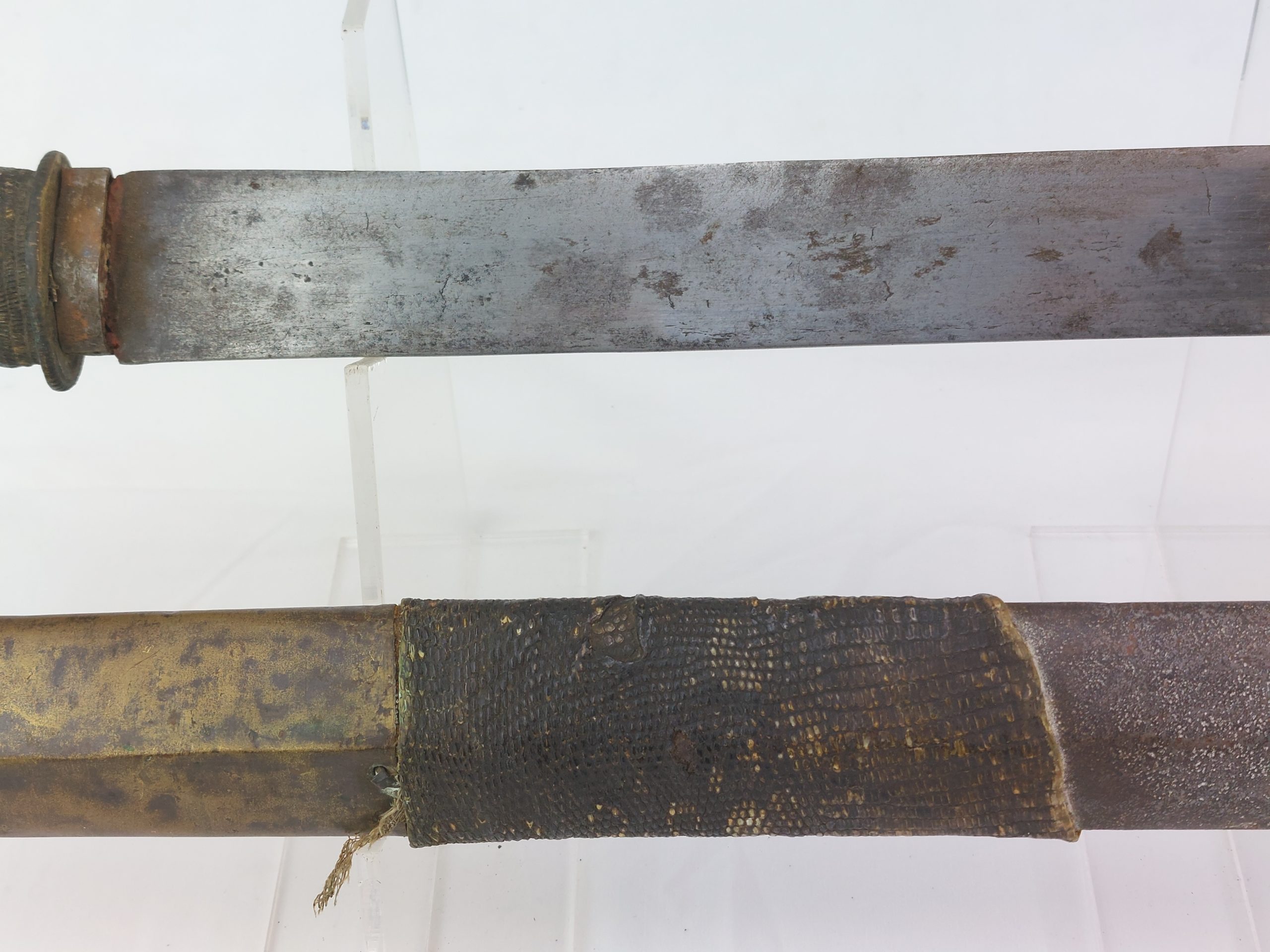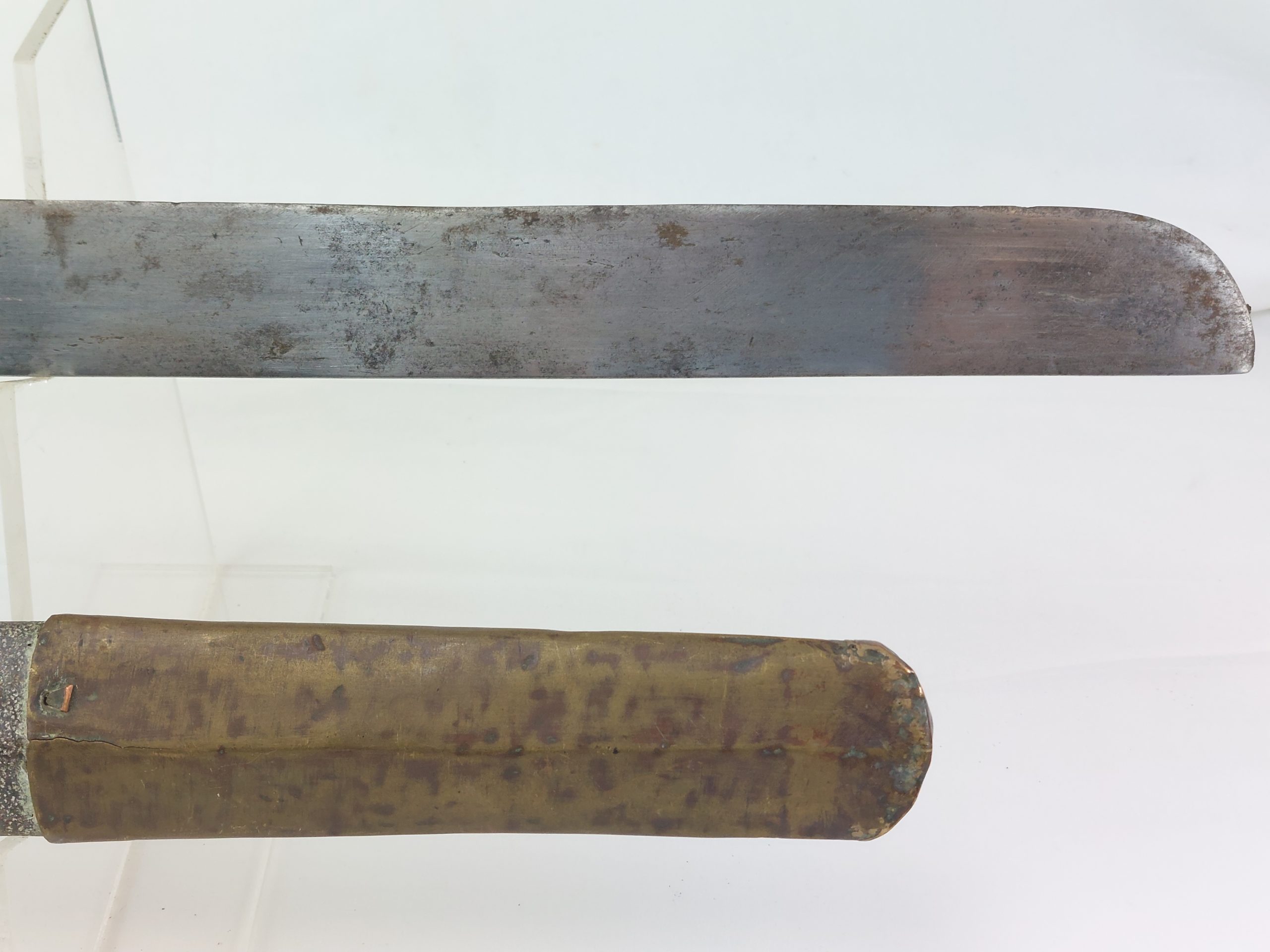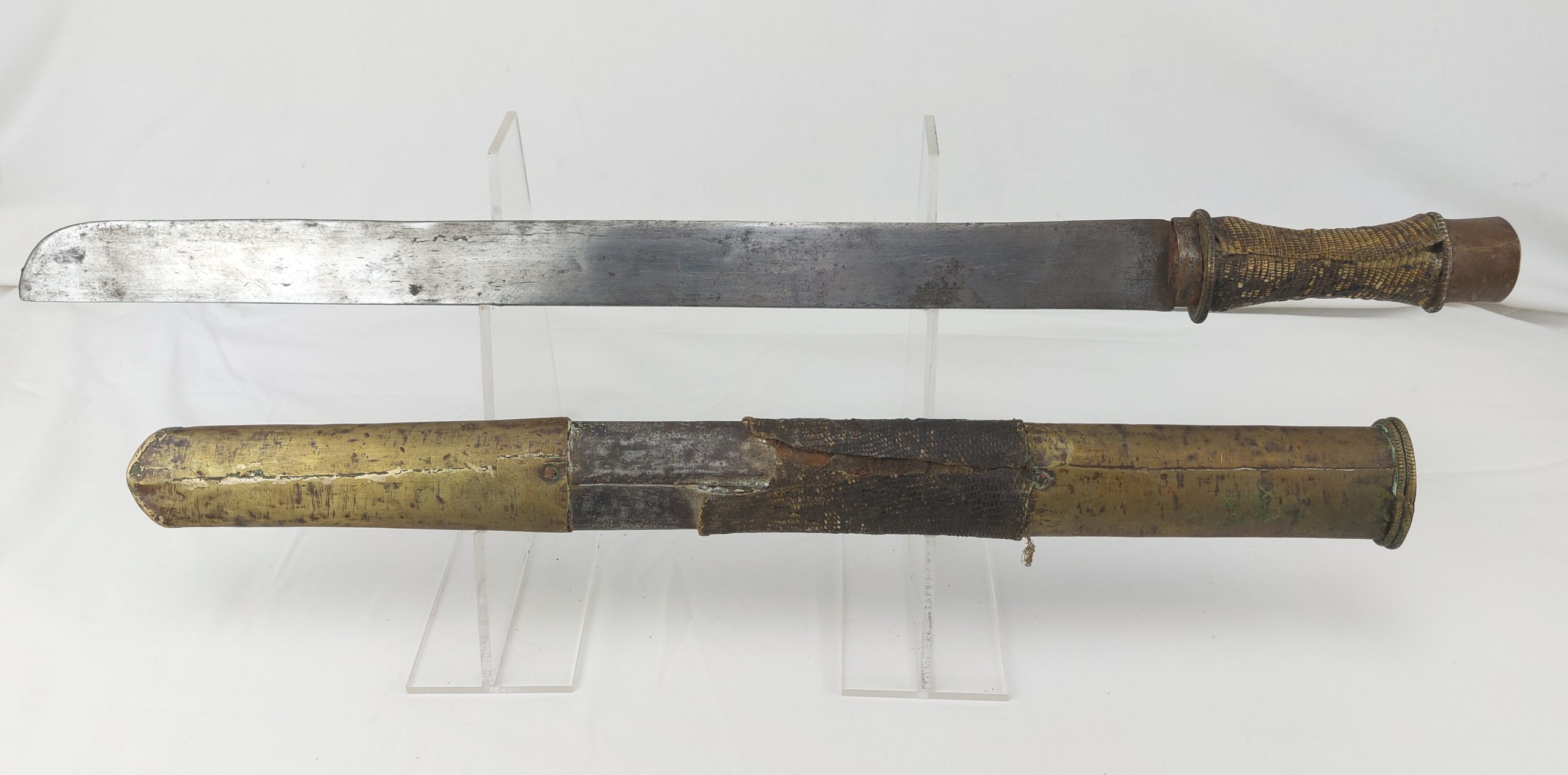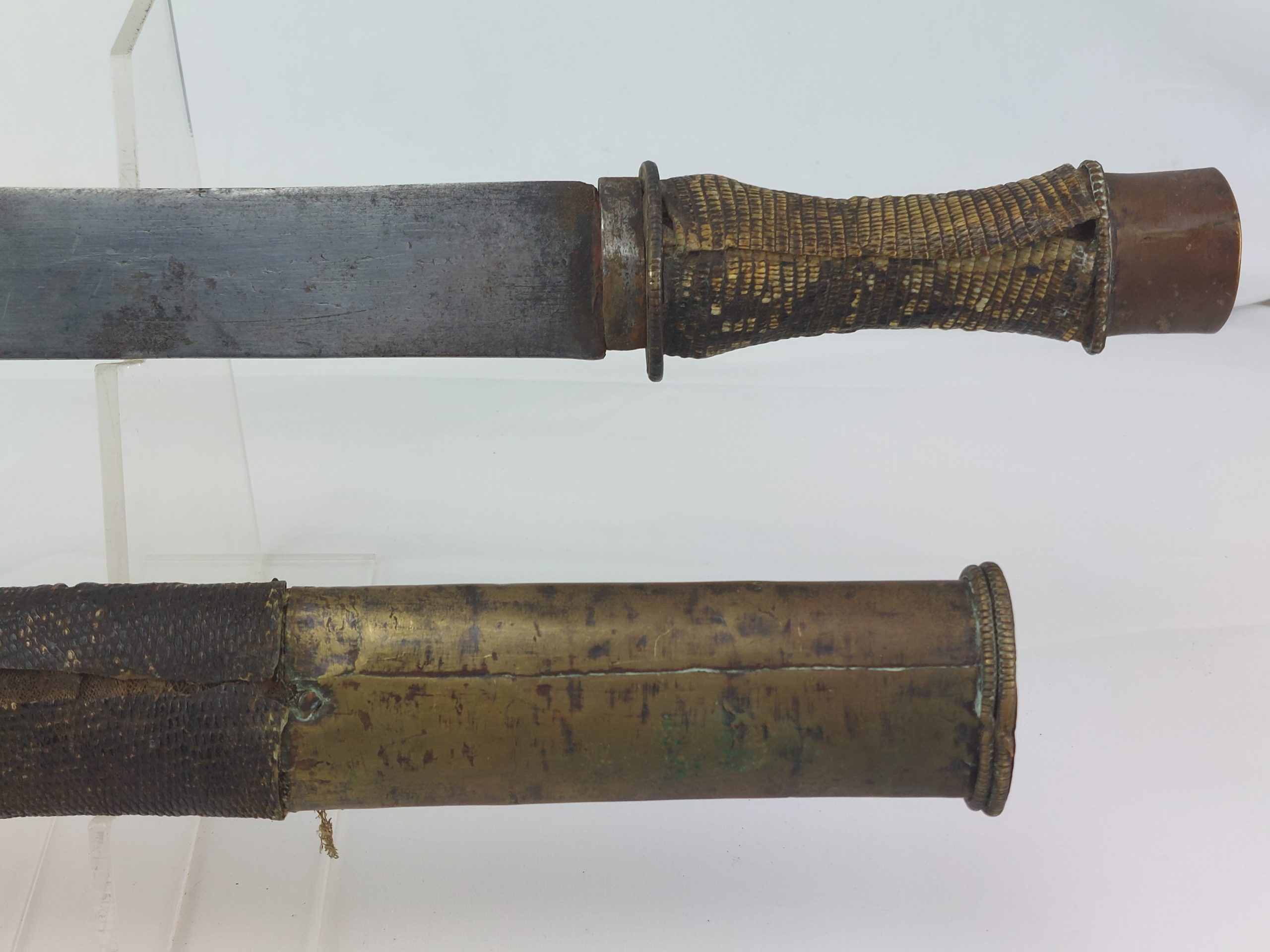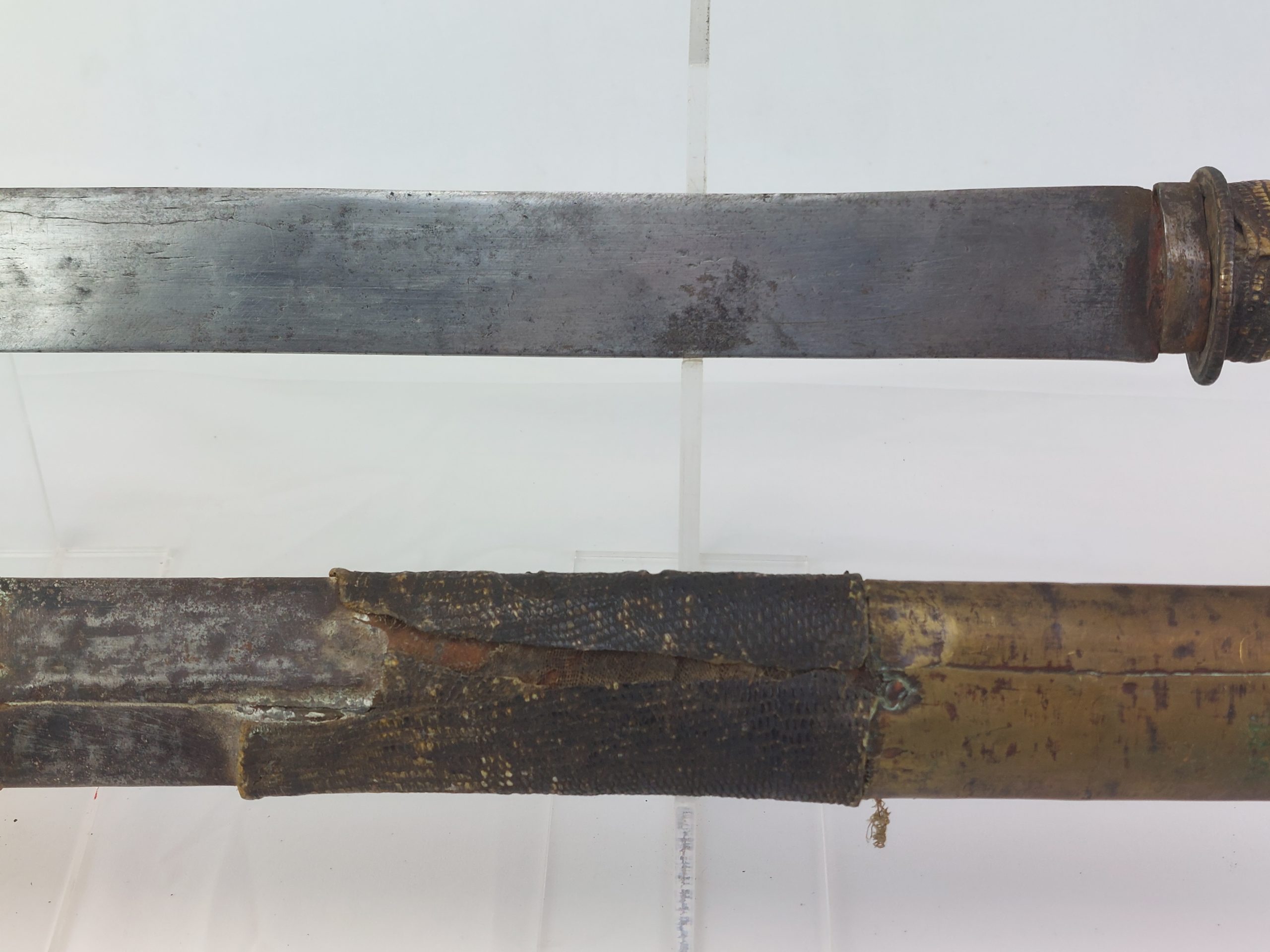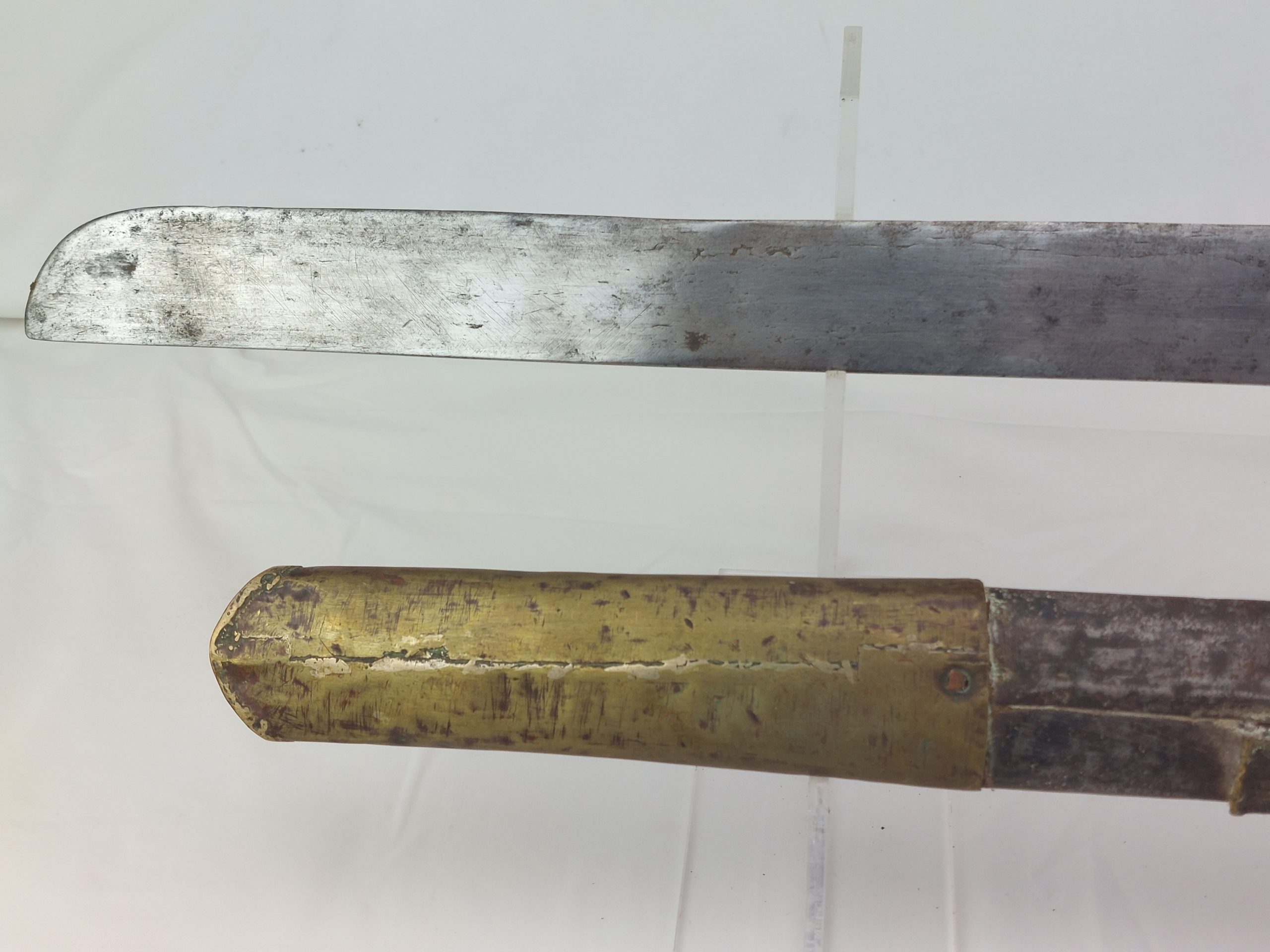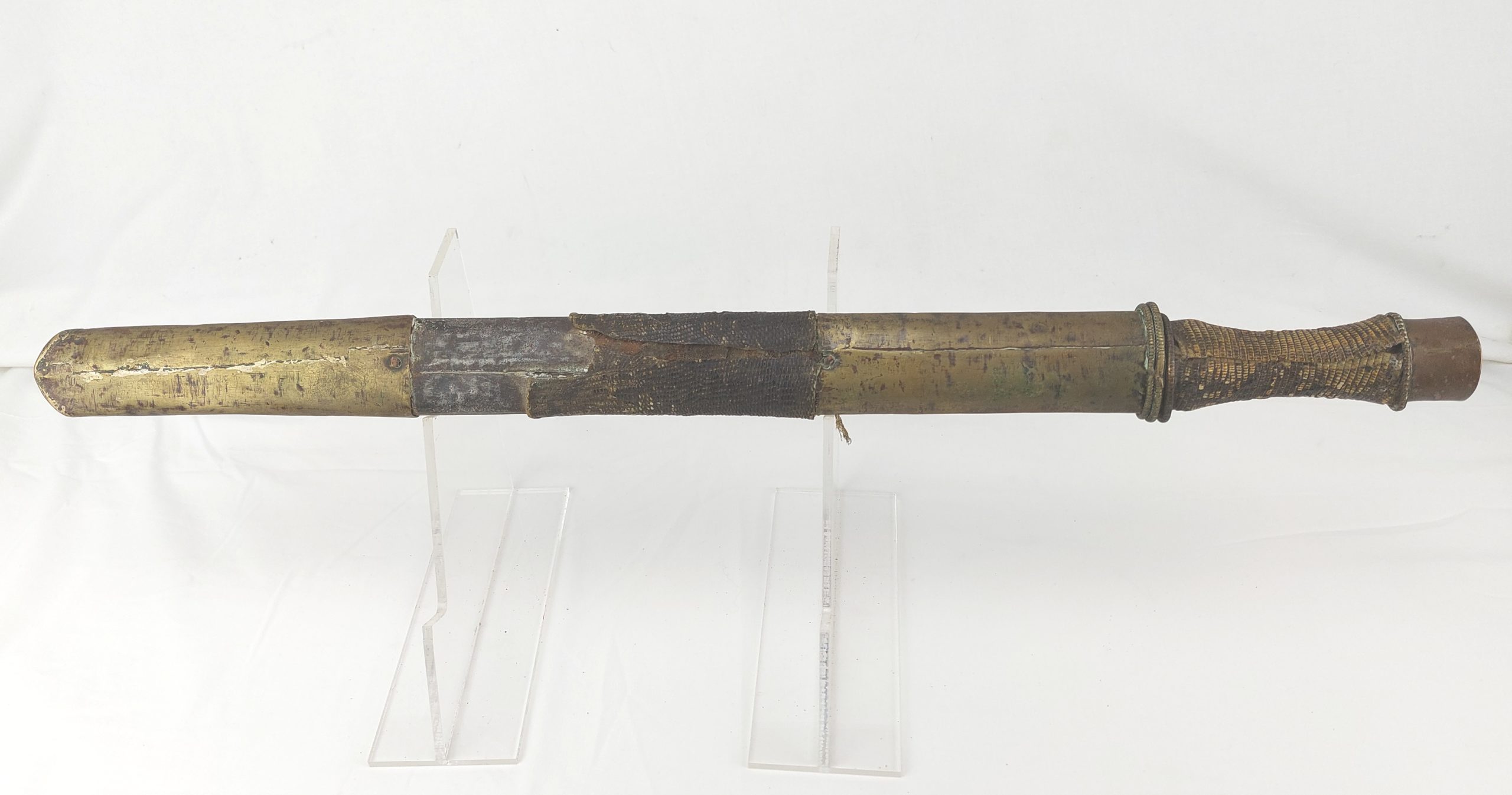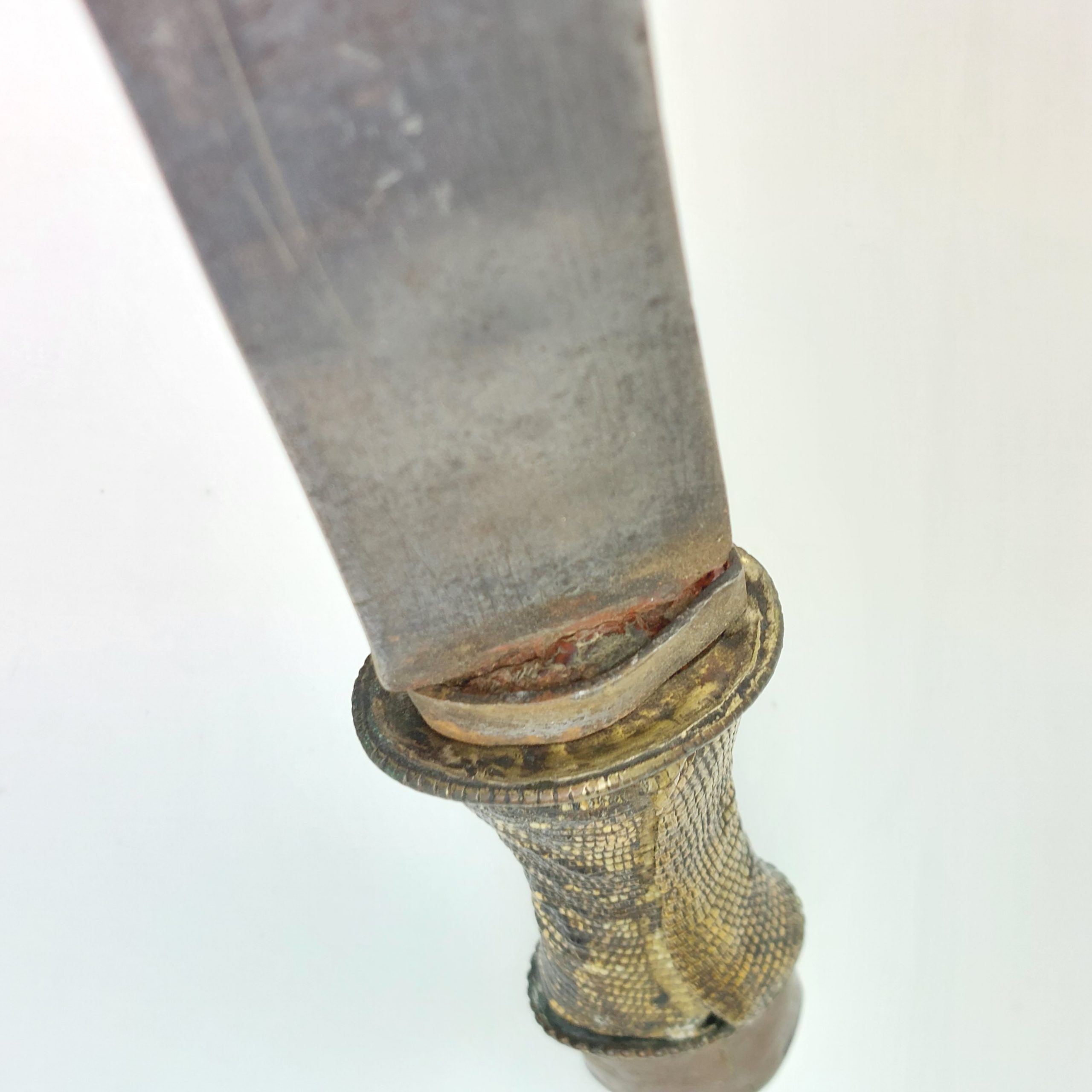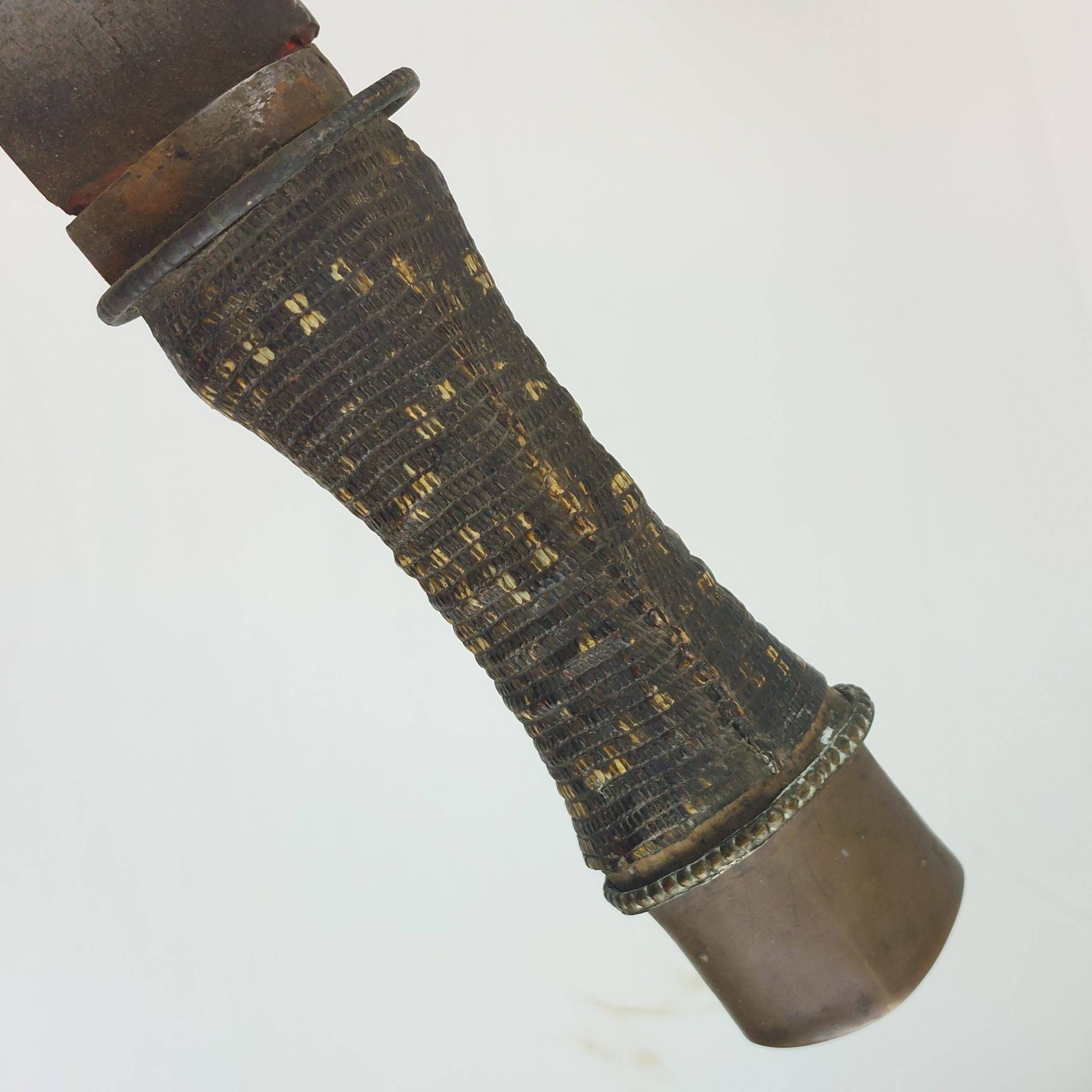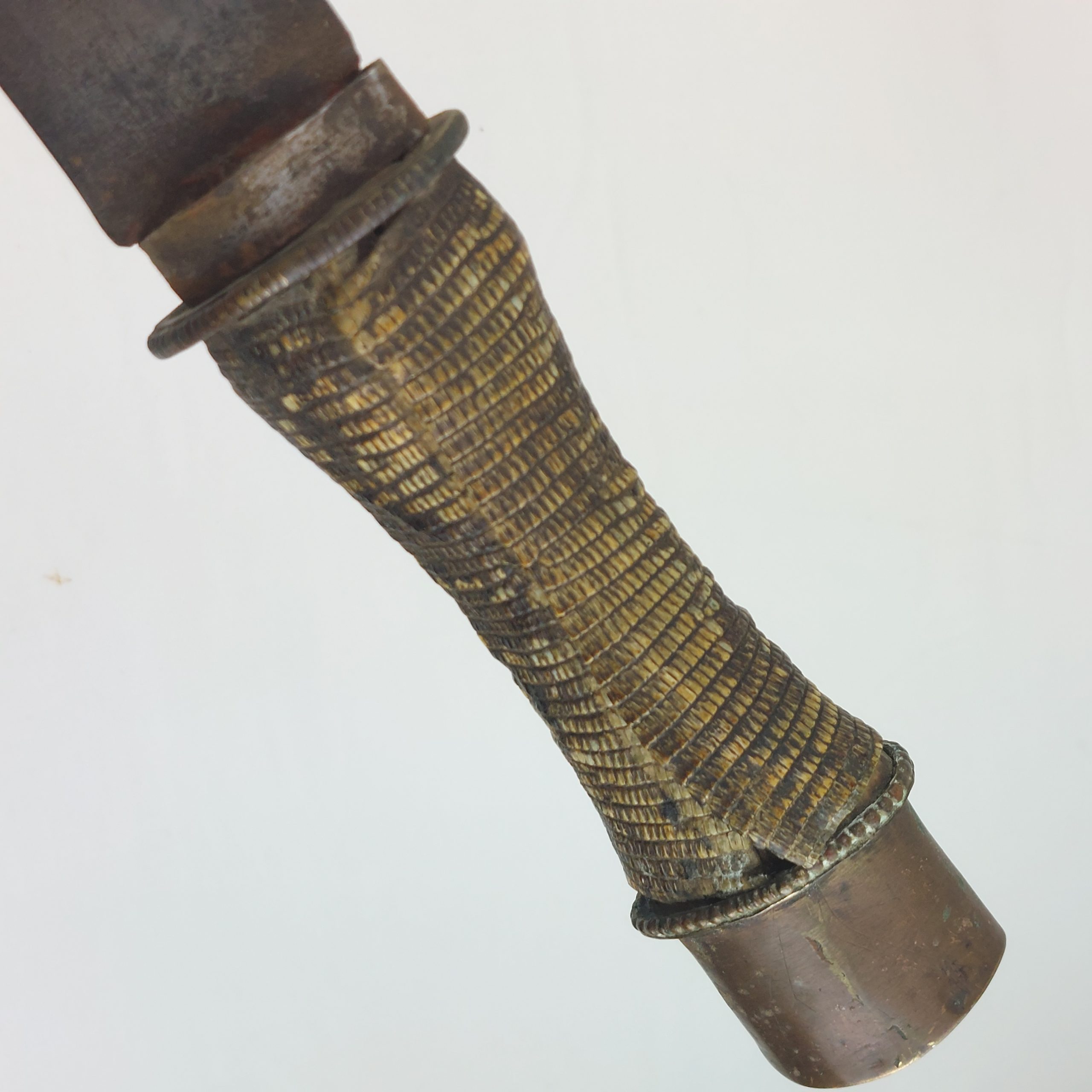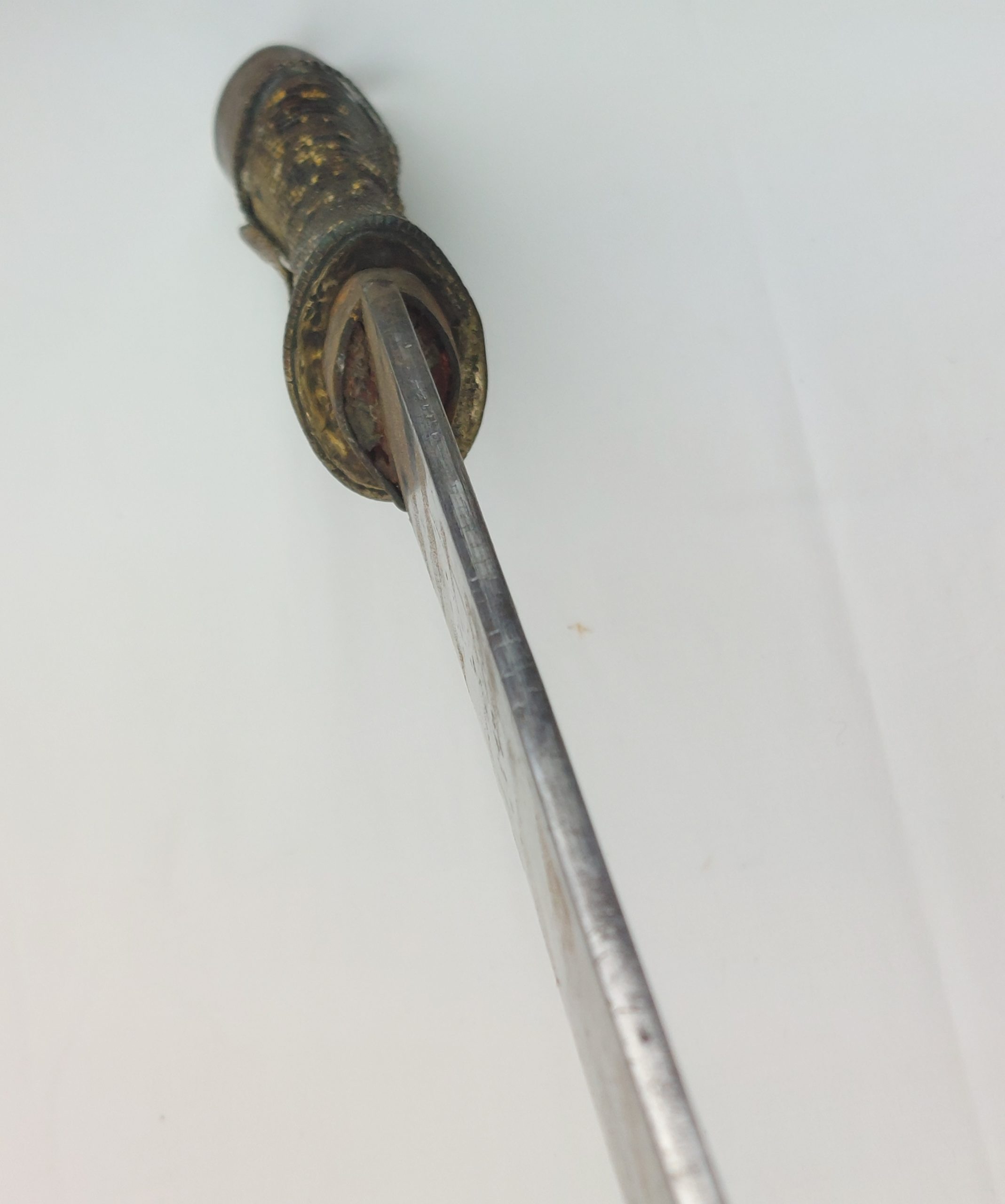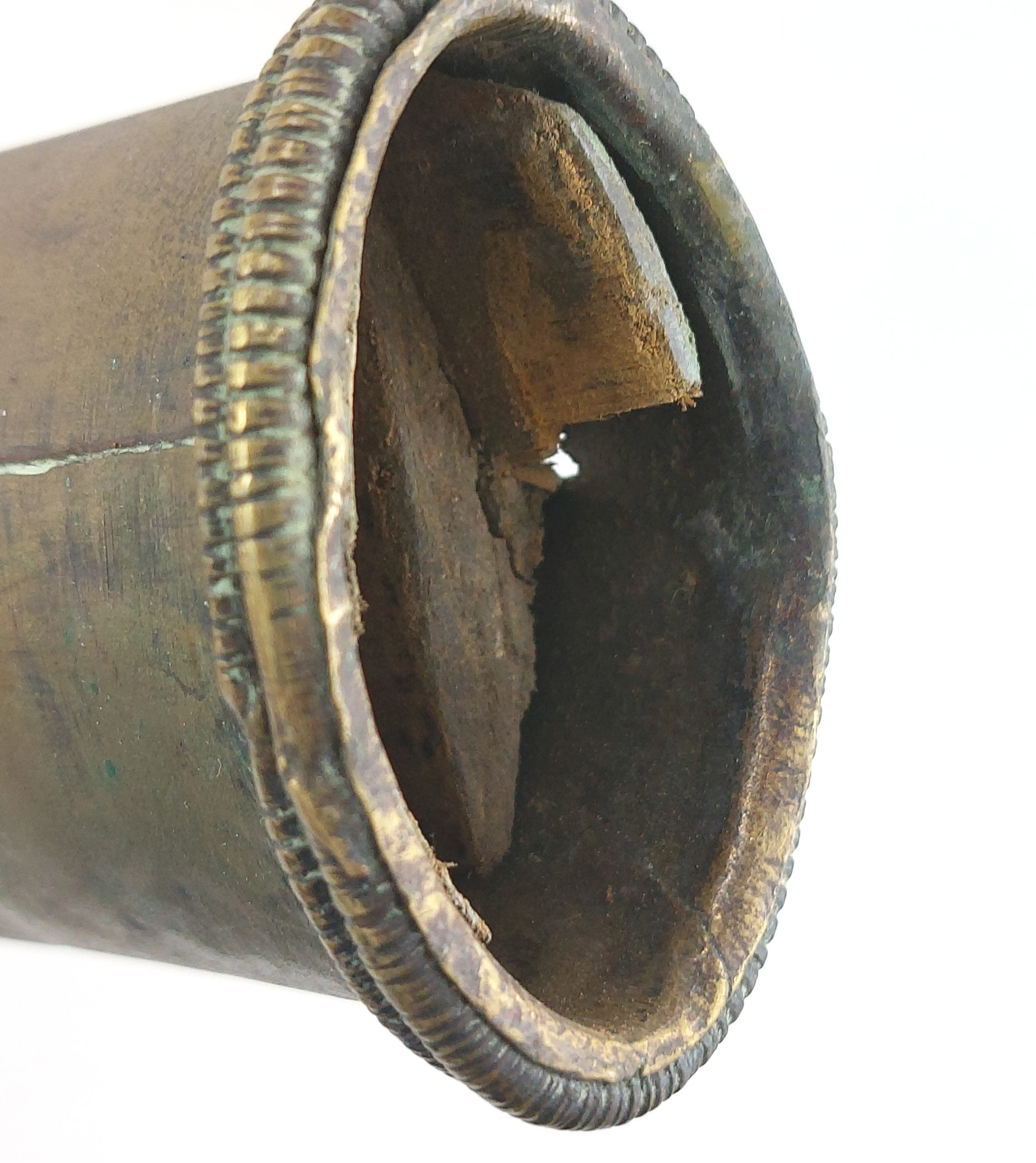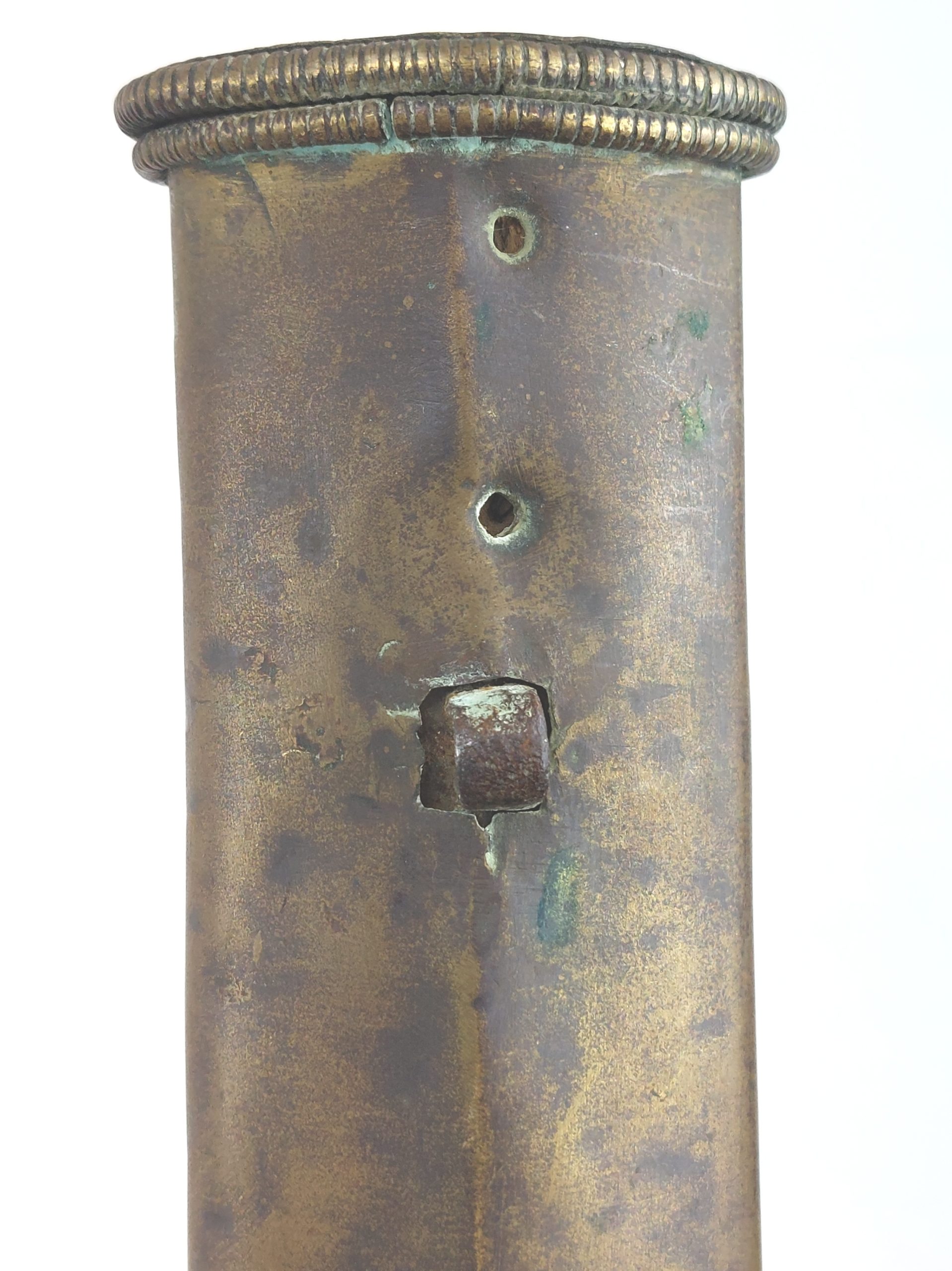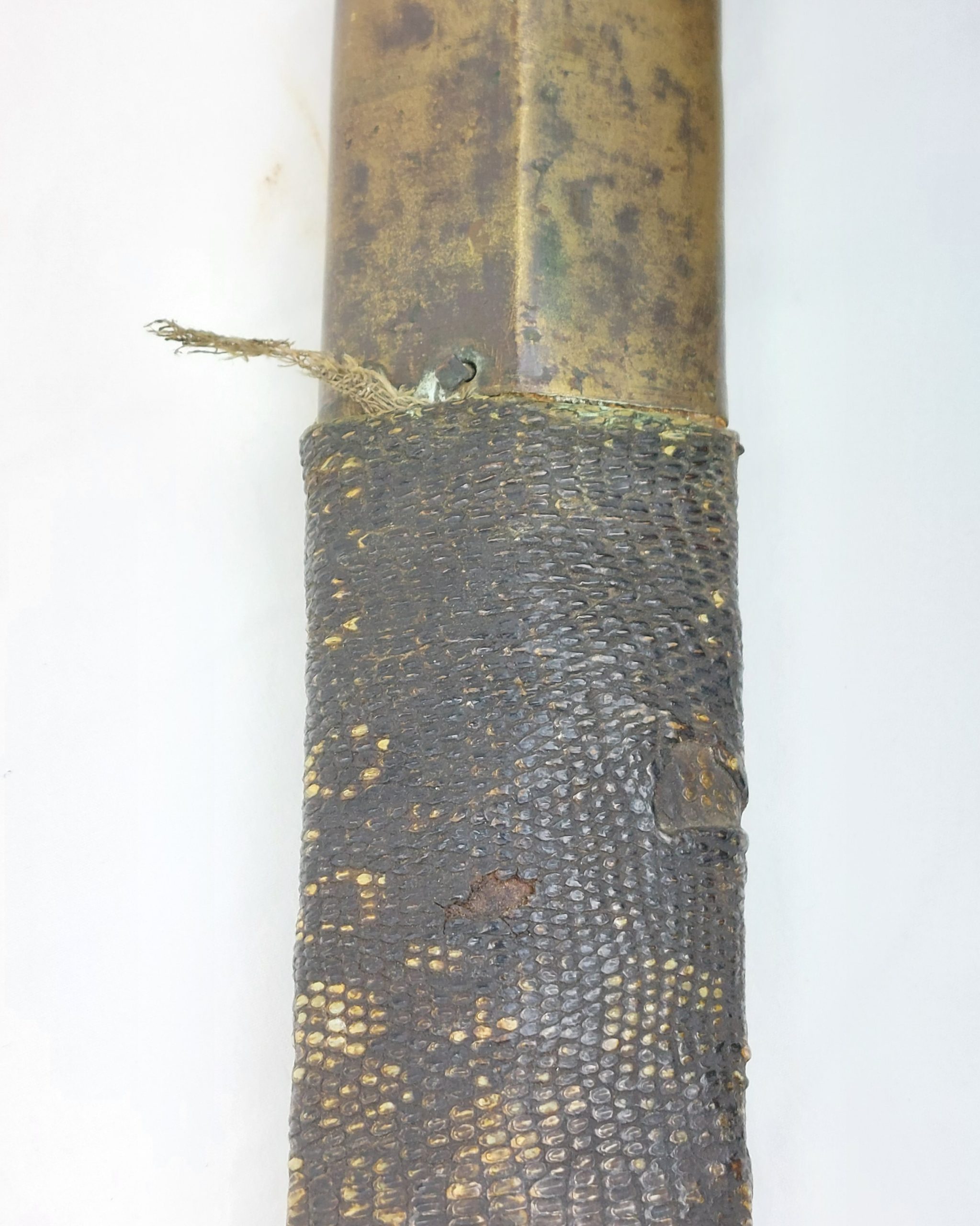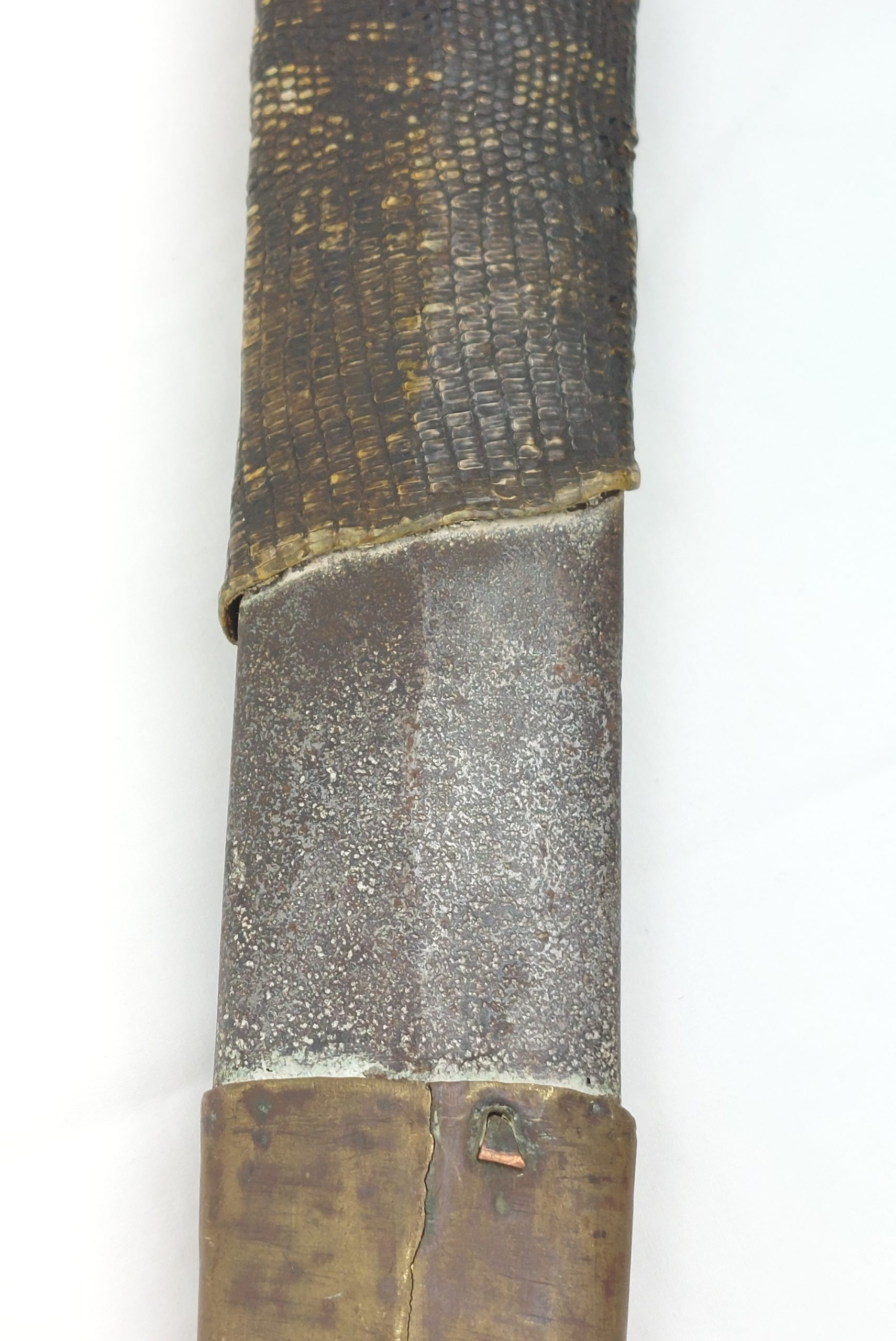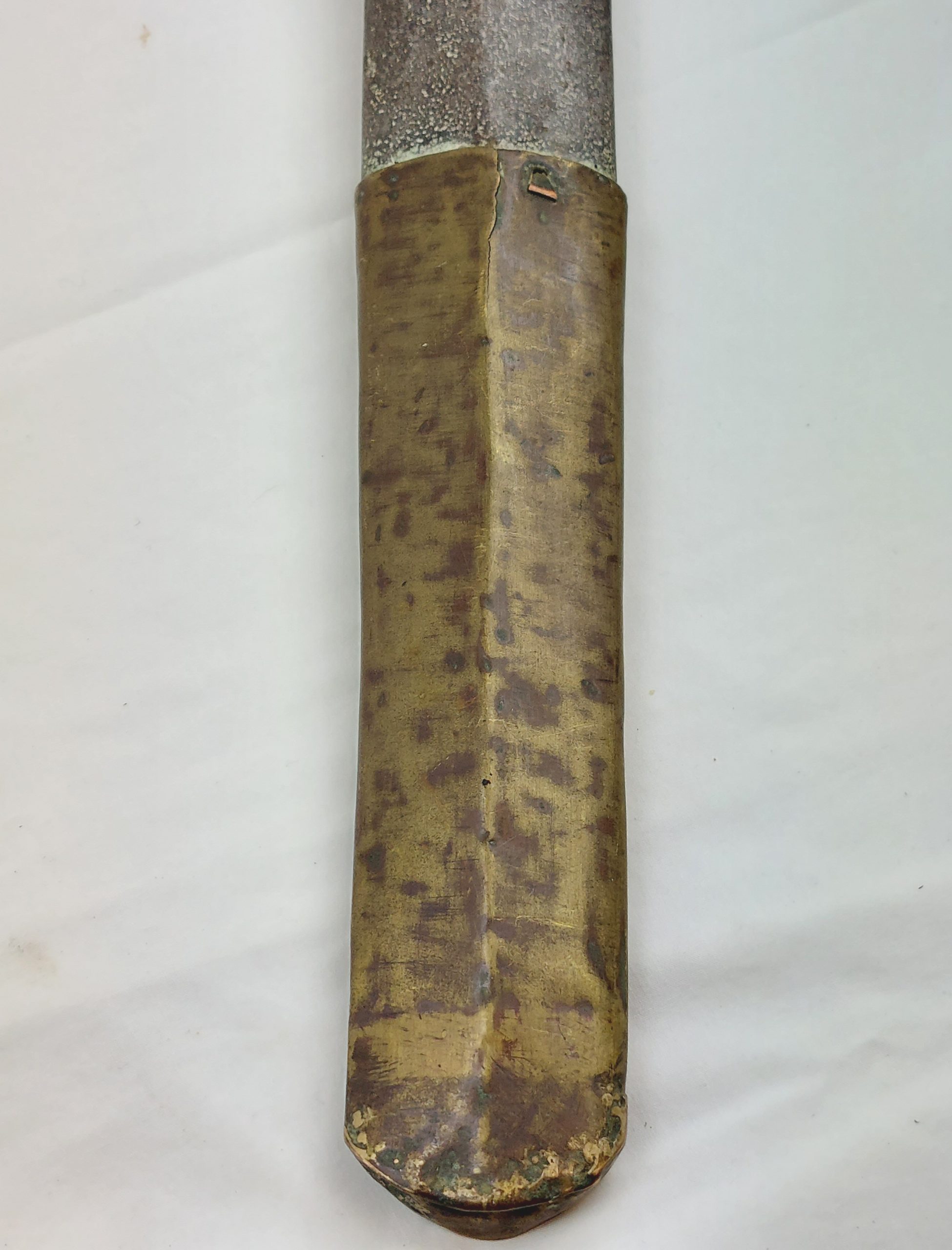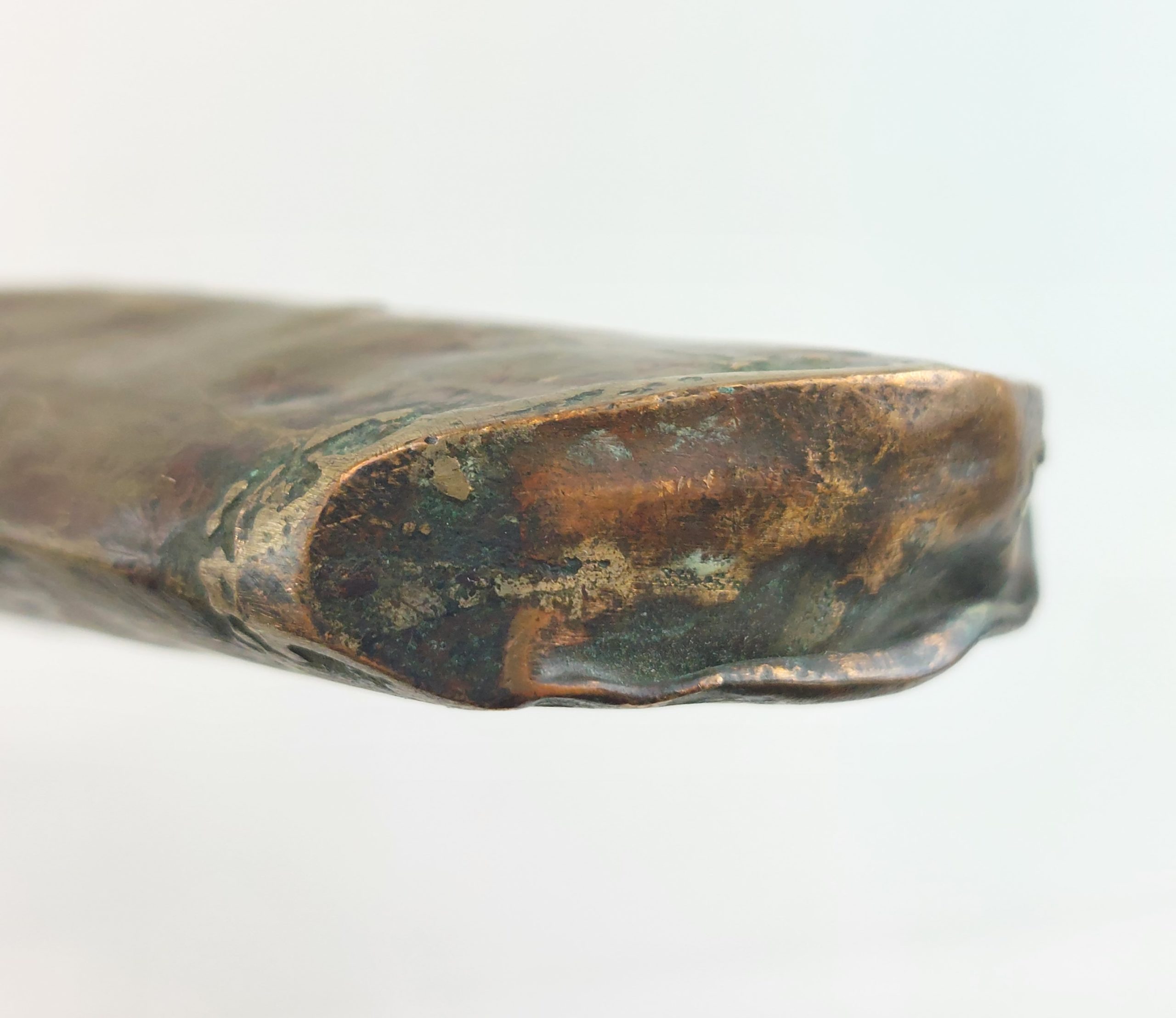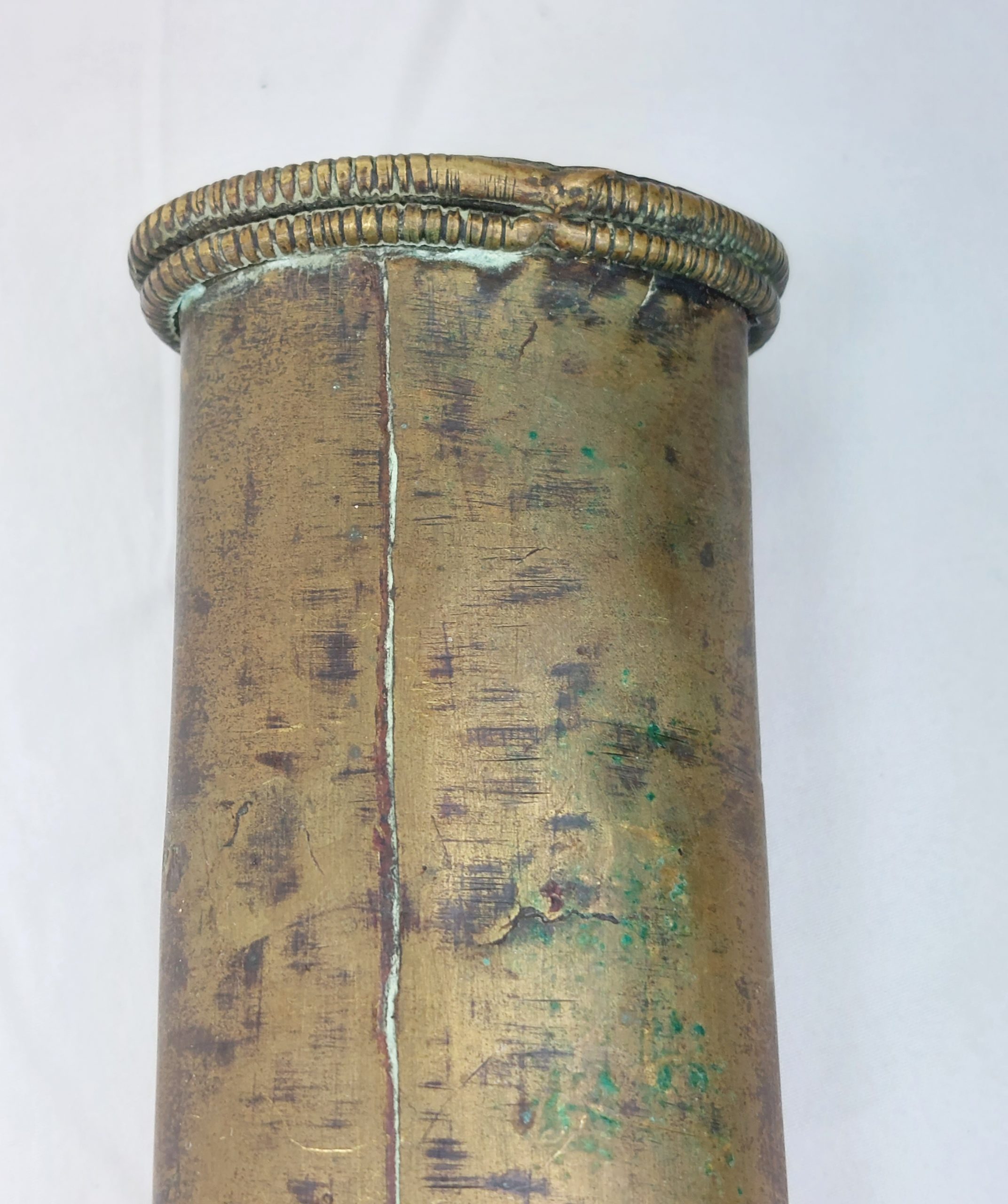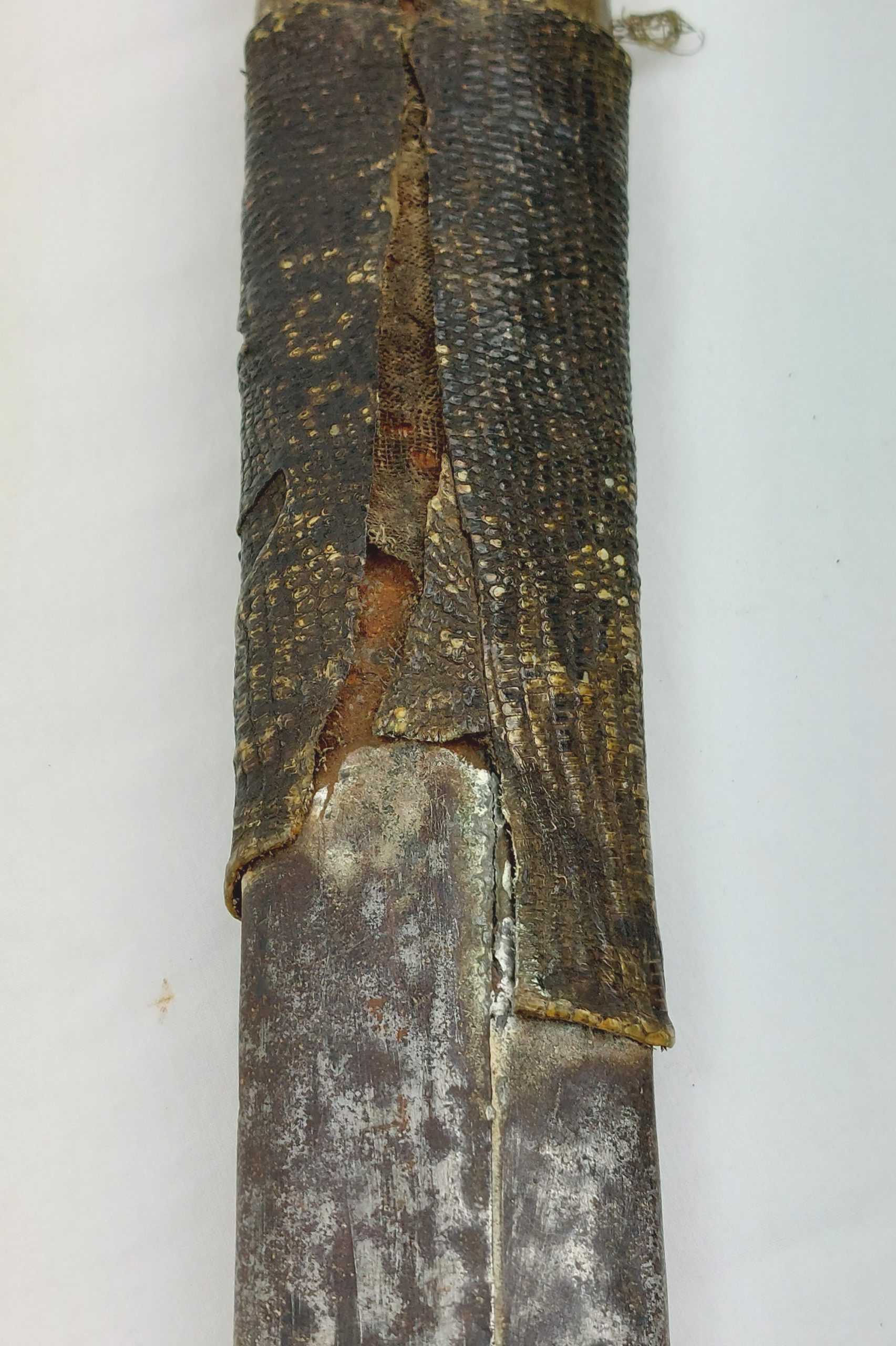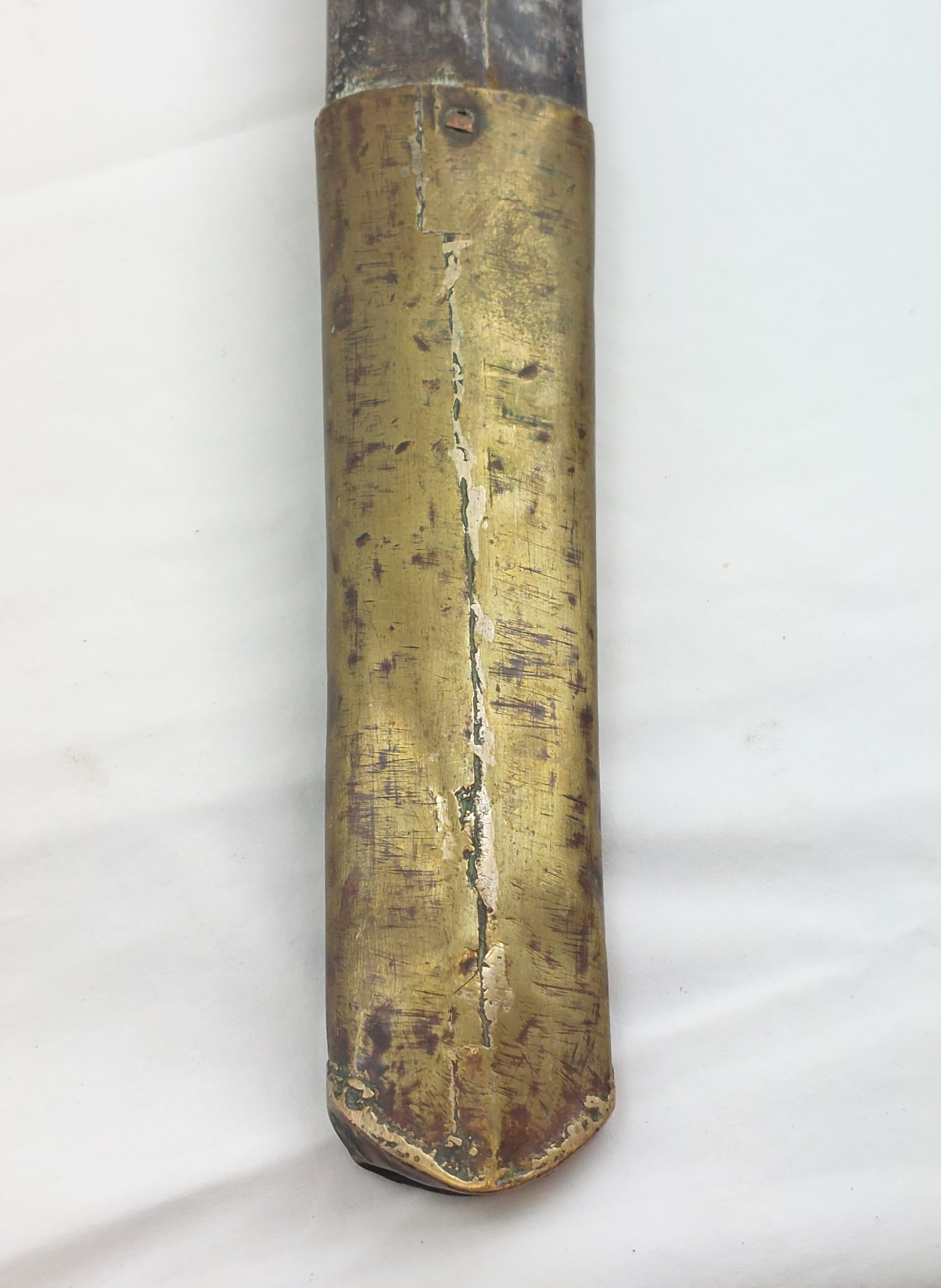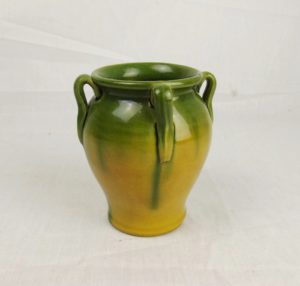*Bhutanese Patag ‘Ben Thaam’ Long Sword with Original Scabbard*
Bhutanese Patag, ‘Ben Thaam’ Long Sword, c18th/19th Century, plain hilt with ray skin grip. The heavy fighting blade straight and slab sided single edge. The hilt is wood with ray skin grips. The grips are bordered with upper and lower brass collars in classic Bhutanese style. The lower collar has an integral bolster whilst the upper offers support for the pommel cap to sit.
Brass scabbard with matching decoration to the hilt. The scabbard is dressed in plain brass mounts and a large and section of ray skin covers the timber core in-between these fittings.
Different types of swords were cast in different localities in
Bhutan. Unlike some Chinese and Tibetan swords which are
sharp, and have double-edged blade, curved sharp tip and
long double-edged tapering blade, Bhutanese swords are all
straight and single-edged blade, with sharp arc tip. “Patag” or “Patang” is a generic term for any kind of knives with enough length and weight to enable them to ‘hack’. Long swords are termed ‘Ben’. There are 4 basic types of design –
1. Ben Thaam – meaning plain
2. Ben Khongsho Chem – a wide fuller on both sides of the blade
3. Ben Washochem – multiple grooves designed along the blade is known as a ‘Washo’
4. Ben Chuuri Chem – referring to the shape of the hair pin lamination of the blade created in the forging.
The blade measures 52.2cm long, 3.8cm wide, 67.3cm overall. The blade is about 40mm wide and the thickness of the edge starts out 5mm near the hilt and 2mm at the tip.
*Condition*
The blade is in excellent condition with few nicks to the blade. There is some pitting but that may also be as a result pf the hair pin process. The hilt is in good condition considering its age. the ray skin grip is intact though discoloured and the brass pommel is good. The brass and fish skin scabbard shows signs of wear and tear and some of the fish skin is missing. This is nonetheless an exciting and historical find that for its age is in great condition. Please see photographs as part of the condition report.
The Bhutanese Patag ‘Ben Thaam’ long sword is a traditional weapon that holds a deep cultural, historical, and symbolic significance in Bhutanese society. The Patag (also spelled as patang or patagha) is a type of long sword traditionally carried by Bhutanese noblemen, high-ranking officials, and warriors. The Ben Thaam refers to a specific style of this sword, noted for its distinct design and craftsmanship.
Cultural and Symbolic Importance
In Bhutan, the Patag is more than just a weapon; it is a symbol of rank, power, and prestige. The sword was historically carried by members of the aristocracy, high-ranking government officials, and military leaders. Even today, the Patag is a part of the ceremonial attire worn by Bhutanese officials during state functions and important events.
The Patag represents honor, authority, and loyalty to the kingdom, and its presentation as a gift from the king signifies recognition of one’s service or position within Bhutanese society. The Patag’s presence in the country’s formal dress code underscores its lasting cultural significance.
Origins and Historical Development
The origin of the Bhutanese Patag is not entirely clear, but it likely developed during the medieval period when Bhutan was emerging as a unified kingdom under the leadership of various warlords and monastic leaders. Swords were used by Bhutanese warriors during the many conflicts that occurred in the region, including skirmishes with Tibetan forces and internal power struggles.
The Patag, including the Ben Thaam style, began to evolve as a representation of Bhutan’s warrior class and the elite members of its society. These swords were not just practical weapons but also status symbols. Over time, they became highly ornate, with intricate decorations on the blade, handle, and scabbard, reflecting the wealth and rank of their owners.
Design and Characteristics of the Ben Thaam Sword
The Ben Thaam Patag is known for its long, straight blade, which is typically made of high-quality steel. The design of the sword is elegant and distinctive, featuring a few key characteristics that set it apart from other traditional swords in Bhutan and the region:
Blade: The blade of the Ben Thaam Patag is relatively straight and tapers to a fine point. It is usually unadorned, focusing on the functional elegance of the weapon rather than heavy decoration.
Hilt and Guard: The hilt, or handle, is often covered with rich materials, such as silver, gold, or brass, depending on the status of the individual carrying it. The guard (the part between the blade and the handle) is also typically decorated, featuring intricate carvings or engravings.
Scabbard: The scabbard, or sheath, is often made of wood and is covered in leather or silk, adorned with metal fittings at the top and bottom. These fittings are frequently decorated with traditional Bhutanese motifs, reflecting both the spiritual and cultural heritage of the owner.
Length: The Ben Thaam is longer than the typical Patag, which gives it an imposing presence. This extended length signifies the sword’s ceremonial role, as it was often carried by high-ranking officials during formal state functions.
Role in Bhutanese Society
The Patag, including the Ben Thaam style, has played several roles throughout Bhutan’s history:
Military Use: Historically, the Patag was used in combat by Bhutanese warriors and soldiers. Bhutan’s geographic location and turbulent history, including invasions from neighboring regions, necessitated the use of such weapons in warfare. However, its use in actual combat declined as firearms and other modern weapons replaced traditional swords on the battlefield.
Symbol of Authority: By the 19th and 20th centuries, the Patag had become more of a ceremonial item than a functional weapon. It was worn by high-ranking officials and members of the Bhutanese aristocracy as a symbol of their authority. The sword’s presence at important functions and meetings was a sign of the wearer’s status and power within the kingdom.
Religious and Spiritual Significance: In Bhutan, swords like the Patag also have a spiritual aspect. Swords in Bhutanese Buddhism can symbolize the cutting through of ignorance and the attainment of wisdom, and they are often associated with protective deities. The Ben Thaam and other Patag swords are sometimes used in religious ceremonies and rituals.
Royal Bestowment: One of the highest honors in Bhutanese society is the bestowment of a Patag by the King. When a Patag is given as a gift, it signifies a deep level of trust and recognition by the monarch. This practice is still followed today, with officials receiving a Patag as part of their formal uniform when appointed to high-ranking positions.
Modern Role and Preservation
Though the Patag is no longer used in combat, it retains its ceremonial and cultural importance. High-ranking government officials and civil servants wear the Patag during official ceremonies, and it remains a key element of the Bhutanese national dress for men known as the “gho.”
The craftsmanship of the Patag, particularly the Ben Thaam style, is also highly valued. Today, master artisans in Bhutan continue the tradition of making these swords using centuries-old techniques. The art of sword-making has been passed down through generations, and the Patag remains an important symbol of Bhutan’s unique cultural identity.
The Bhutanese Patag ‘Ben Thaam’ long sword is a highly significant cultural artifact in Bhutan. Once used by warriors in battle, it has evolved into a powerful symbol of status, authority, and honor within Bhutanese society. Its elegant design, ceremonial importance, and connection to Bhutan’s spiritual traditions make it a treasured object, reflecting the country’s history, craftsmanship, and values.


